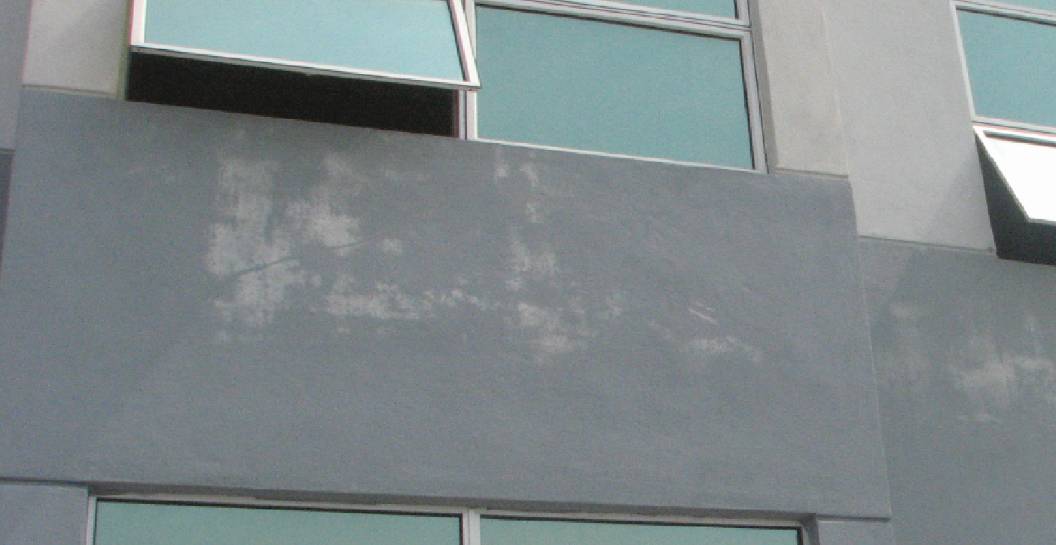Features of Problem
The adhesion of paints to surfaces is due to a component of paint called a “binder” that acts like a glue that binds the pigment and paint components together. It builds the paint film to be able to coat the surface and adhere to the surface. It is durable to sunlight, alkali resistant, moisture resistant, and some types are resistant to chemicals and abrasion.
The low paint adhesion problem occurs between the dried paint film and the surface to which the paint film is adhered. It can occur in many ways such as partially come off, the film is broken into small pieces or when the paint has come off, the paint film can be pulled off completely.
Causes
The low paint adhesion problem can be found both internally and externally. There are several reasons for the occurrence as follows:
1. If the surface before painting has poor surface preparation with dirt, dust, grease, mold stains or moss, it often causes poor adhesion of paint on the surface leading to the low paint adhesion problem. It is often found with a lot of dusty walls especially the walls that are plastered with powder skim coat, gypsum board joints that are putty joints with gypsum powder or caused by the surface that is a prefabricated wall panel that may be oily from the formwork, such as precast sheets, GRC sheets, etc. If the surface is not properly prepared and the dirt stains are not cleaned from the surface, the paint will have less adhesion to the surface.
2. Weather is also a cause of low paint adhesion problem. Exterior paints exposed to harsh weather conditions such as sunlight, UV rays, heat, wind, rain and pollution, cause the paint film to be destroyed over time.
3. The paint film will deteriorate. The adhesion of the paint film to the wall is lower leading to the low paint adhesion problem. Each paint has a different weather resistance. When choosing the paint, you should choose a type that is resistant to weather conditions. It will help extending the usage period of the paint film.
4. How to choose a paint to suit the surface is another precaution to avoid low paint adhesion problem because some paints are not recommended to be applied on certain surfaces.
How to solve
1. Scrape off the old paint film that has deteriorated or peel off. It is recommended not to use a wire brush. Clean the walls from dust, dirt, grease and other foreign matters.
2. The surface must not have cracks. If any, cracks must be repaired with quality material prior to coating. Where cracks are less than 2 mm in size, cracks are repaired with Nippon Paint Vinilex Wall Putty. For cracks larger than 2 mm, fill with Terracryl.
3. For the areas with moss and fungi, scrub with Nippon Paint Vinilex Biowash fungicide and apply Nippon Paint Vinilex Biowash fungicide. Leave it overnight. The surface before painting must be clean and completely dry. If following Nippon Paint standards, the moisture content must not be more than 6% by Kett model HI-520 or not more than 14% by Protimeter Mini and not more than pH8.
4. Apply 1 coat of old plaster primer (recommended paint system for exterior: 1 coat of Old Cement Primer, Nippon Paint Excel Primer, recommended paint system for interior: 1 coat of Nippon Paint Water-Based Primer Aqua Sealer) and 2 coats of Topcoat (Recommended colour system for exterior: 2 coats of Nippon Paint Weatherbond, recommended paint system for interior: 2 coats of Nippon Paint Aircare).
How to prevent
Paint work according to the correct steps must pay attention to the surface preparation process. The surface before painting must be clean free from dust, dirt, grease and other foreign matter and completely dry without cracks to prevent water and moisture from seeping into the wall.
For heavily dusty surfaces such as walls that are smoothed with powder skimcoat, gypsum board joints that are putty joints with gypsum powder, choose to use a clear foundation system with good infiltration enhancing adhesion and strength to the wall before painting the next layer.
Oil-based transparent foundation: 1-2 coats of Nippon Paint Excel Primer
Water-based transparent foundation: 1-2 coats of Nippon Paint Aqua Sealer




















